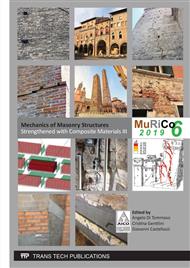p.182
p.189
p.195
p.205
p.213
p.221
p.229
p.236
p.244
Experimental and Numerical Analysis of FRCM Strengthened Parabolic Tuff Barrel Vault
Abstract:
This work focuses on an experimental and numerical study of a tuff barrel vault first damaged by differential vertical settlements of the abutments without rotations, then reinforced with a FRCM system composed by a fiber-reinforced mortar embedding a basalt fiber net, and finally subjected to a concentrated load on a generatrix (still ongoing). The geometry of the vault (polycentric near parabolic shape) and the masonry material (Apulian tuff) have been chosen in order to be representative of some masonry vaults common in rural constructions of Apulia region; also, a load representative of the infill weight has been applied during all the experimental tests. In parallel to the experiments, numerical simulations by a heterogeneous FE Abaqus model calibrated on the experimentally determined mechanical properties of materials have been performed. This model aims at reproducing the settlement phase and to accurately predict the load bearing capacity of the reinforced structure. To this aim, Concrete Damage Plasticity model has been used for modeling mortar joints and cementitious matrix, whereas tuff bricks have been assumed linearly elastic; finally, the basalt fiber net used in the FRCM reinforced has been described by suitable equivalent elasto-damaging trusses.
Info:
Periodical:
Pages:
213-220
Citation:
Online since:
August 2019
Price:
Сopyright:
© 2019 Trans Tech Publications Ltd. All Rights Reserved
Share:
Citation:


